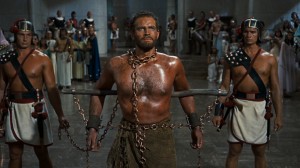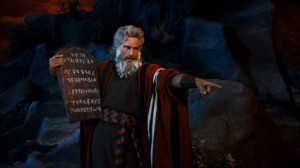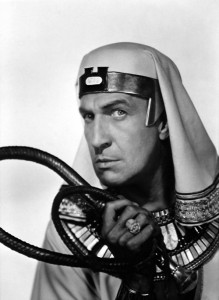100 Film Favorites – #39: The Ten Commandments (Cecil B. DeMille, 1956)  “So let it be written, so let it be done.” We kick off the 30s with a film truly deserving of a label so often tossed about in recent years…epic. The Ten Commandments, was the final film directed by Cecil B. Demille, a director already well-known for the flamboyant, sweeping nature of his films, and it stands alongside movies like Ben-Hur as one of the best examples of the cinematic epic, from an era in which the genre was in its top form. While “epic” movies continue to be made today, such films often rely heavily on computer graphics to supply much of their scale and imagery. But in the 50s and 60s, making films like The Ten Commandments was truly an epic undertaking, requiring colossal budgets (when adjusted for inflation, still among the biggest ever), armies of craftsman capable of designing and building city-sized sets, and the proverbial “cast of thousands.”
“So let it be written, so let it be done.” We kick off the 30s with a film truly deserving of a label so often tossed about in recent years…epic. The Ten Commandments, was the final film directed by Cecil B. Demille, a director already well-known for the flamboyant, sweeping nature of his films, and it stands alongside movies like Ben-Hur as one of the best examples of the cinematic epic, from an era in which the genre was in its top form. While “epic” movies continue to be made today, such films often rely heavily on computer graphics to supply much of their scale and imagery. But in the 50s and 60s, making films like The Ten Commandments was truly an epic undertaking, requiring colossal budgets (when adjusted for inflation, still among the biggest ever), armies of craftsman capable of designing and building city-sized sets, and the proverbial “cast of thousands.” 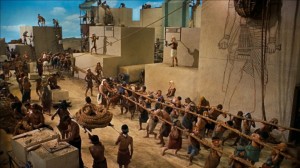 The movie recounts the Biblical tale of the Hebrew slaves’ exodus from bondage in ancient Egypt. Charlton Heston stars as Moses, and Yul Brynner plays Rameses II, Moses’ “brother” who becomes his main enemy. The film presents many aspects of Moses’ life which do not appear in the Bible, drawing from sources such as the Quran, apocryphal scriptures, and midrashim, rabbinic scholarship. This includes an increased focus on Moses’ youth spent as a Prince of Egypt, leading successful military campaigns and building projects and earning more of his “father” Pharaoh Seti’s favor than Rameses, the heir to the throne. This helps set up a rivalry between Moses and Rameses from a young age, particularly with the addition of a shared love interest in the manipulative Nefretiri, who plays the two men against each other.
The movie recounts the Biblical tale of the Hebrew slaves’ exodus from bondage in ancient Egypt. Charlton Heston stars as Moses, and Yul Brynner plays Rameses II, Moses’ “brother” who becomes his main enemy. The film presents many aspects of Moses’ life which do not appear in the Bible, drawing from sources such as the Quran, apocryphal scriptures, and midrashim, rabbinic scholarship. This includes an increased focus on Moses’ youth spent as a Prince of Egypt, leading successful military campaigns and building projects and earning more of his “father” Pharaoh Seti’s favor than Rameses, the heir to the throne. This helps set up a rivalry between Moses and Rameses from a young age, particularly with the addition of a shared love interest in the manipulative Nefretiri, who plays the two men against each other.
What Moses doesn’t know is that he is actually of Hebrew birth, having been cast adrift on the Nile as a baby to escape a previous Pharaoh’s order to slaughter all male Hebrew children. You know, evil kings really need to stop trying to eliminate “deliverers” and “chosen ones” with mass purges. They always seem to slip through the cracks. At any rate, baby Moses washed ashore near the Egyptian palace, where the princess discovered him and raised him as her own. Moses eventually discovers the truth of his lineage from Nefretiri, who in turn learns it from a treacherous servant. Moses attempts to rule over his enslaved people with a kinder hand, but when he catches and kills a slave-driver (Vincent Price) for abusing the slaves, Moses is arrested and his secret revealed. Seti orders him stripped of his royal title, stricken from the historical record (an awesome ancient punishment known as “damnatio memoria“), and banished to the desert.
Moses wanders through the desert, suffering from thirst and hunger, until he comes to an oasis. Here a group of young women are watering their flock, and Moses defends them from ambush by brigands. The women are daughters of Jethro, the prosperous leader of a tribe of free Hebrews who live nearby, and Moses is invited into the little community. The years pass, and Moses weds Jethro’s eldest daughter Sephora and starts a family. Things are pretty hunky-dory for the exiled former prince until one day, when God appears to Moses in the form of a burning bush and commands him to implore Pharaoh to release the Hebrew slaves.
Moses schleps back to Egypt, where he finds that Rameses has become Pharaoh, married Nefretiri, and fathered a son of his own. Nefretiri nonetheless resorts to her old tricks and promptly tries to seduce Moses. He rebuffs her, stating that, in addition to them both being married, he has found God and been charged with a holy mission. This assertion is met with a pout of epic proportions. Moses confronts Rameses and demands the release of his people. Moses performs a few God-powered magic tricks, such as morphing his staff into a snake, to convince Rameses of God’s might, but Rameses is unmoved. Moses warns him that if the Hebrews are not released, God will visit a series of disastrous plagues upon the people of Egypt. But Pharaoh’s resolve is strong, so God gets down to some serious visitin’. In a sequence featuring some pretty spectacular special effects for the era, we see the Nile turned to blood and hailstones exploding into flame upon hitting the ground. Finally, in an eerily silent scene, the “Angel of Death,” a finger of sickly green light, descends over Egypt and extinguishes the life of every first-born Egyptian child. This includes the son of Rameses himself, and the heartbroken Pharoah concedes to free the slaves.
Moses leads his people out of Egypt en masse, assisted by Joshua, a young man who has endeared himself to Moses and serves as his second-in-command. The jubilant Jews make it to the shore of the Red Sea before realizing that Pharaoh, whipped into a vengeful rage (spurred on once again by that puppet-master Nefretiri), is pursuing them with his army. In the greatest show of God’s power yet, Moses raises his staff and parts the Red Sea, while a pillar of fire blasts down from the sky and blocks the Egyptians’ path. The Hebrews begin to hurry across the seabed. When they are nearly across, the fire abates and the soldiers rush after them into the sea…which rushes closed immediately after the last Hebrew sets foot on the other side. Much of Egypt’s army is washed away, and a defeated Rameses mutters, “His God IS God.” 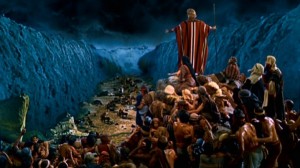 Though the main arc of the story is completed, we still haven’t gotten to the titular objects yet. Moses leads the Hebrews through the vast desert, eventually ascending solo to the top of Mount Sinai to pow-wow with God. While he is away, the other Hebrews grow restless. Feeling fed-up with Moses’ seemingly aimless wandering, the former slaves craft a golden idol for themselves and rapidly descend into orgiastic revelry. Despite Joshua’s best efforts to keep them on the straight and narrow, the Hebrews persist in getting their freak on. Suddenly, Moses returns to ruin the fun. He comes bearing…THAT’S RIIIGHT…The Ten Commandments, God’s laws for his chosen people, engraved on two stone tablets. Seeing the depraved state of the revelers, Moses smashes the tablets.
Though the main arc of the story is completed, we still haven’t gotten to the titular objects yet. Moses leads the Hebrews through the vast desert, eventually ascending solo to the top of Mount Sinai to pow-wow with God. While he is away, the other Hebrews grow restless. Feeling fed-up with Moses’ seemingly aimless wandering, the former slaves craft a golden idol for themselves and rapidly descend into orgiastic revelry. Despite Joshua’s best efforts to keep them on the straight and narrow, the Hebrews persist in getting their freak on. Suddenly, Moses returns to ruin the fun. He comes bearing…THAT’S RIIIGHT…The Ten Commandments, God’s laws for his chosen people, engraved on two stone tablets. Seeing the depraved state of the revelers, Moses smashes the tablets.
Then, in a quick blow-by-blow, the movie sums up the remainder of the book of Exodus. Moses eventually re-carves the Commandments, and the Hebrews store them in the Ark of the Covenant. Because of their misdeeds, the former slaves must wander the desert for 40 years. Finally, after what I can only assume was four decades of walking in a very large circle, Moses stands at the edge of Canaan, the foretold “Promised Land.” God tells him he will die without ever entering Canaan, but that Joshua shall lead the Hebrews into the land and a new era of prosperity. The Ten Commandments is an epic in every aspect of its production. Huge sets include an Egyptian “treasure city” replete with massive statues and obelisks, and the costumes are equally lavish. The fanfare-like score is suitably big, brash, and brassy. Perhaps most impressive is the literal “cast of thousands”: Hordes of Hebrew slaves and Egyptian Soldiers (with an occasional Ethiopian dancer thrown in for good measure) fill one sweeping frame after another. It’s a truly vast production, matching the legendary scope of the original Exodus tale. 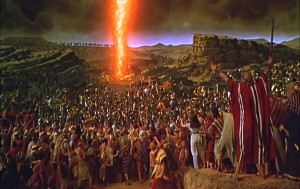 The only place where the filmmakers very obviously pulled a cinematic punch occurs when Moses transforms his staff into a snake to demonstrate God’s power to Pharaoh, and Pharaoh has his own magicians repeat the trick with their staves. This transformation is accomplished through a decent stop-motion sequence. We next see looks of horror on the Egyptians faces – “Look!” screams one, “Moses’ snake devours the others!” This “devouring,” however, is not shown. Presumably the crew couldn’t make the actual snakes eat each other, but come on! You’ve got pillars of fire, a river of blood, a parting sea, and the Angel of Death. You should at least be able to muster up an effects shot of snakes being eaten. Have Ray Harryhausen do it! He’s great at that stuff! Oh well. Despite its complete lack of snakes eating other snakes, the film won the Academy Award for Best Visual Effects, and was nominated for six others, including Best Picture, which it lost to Around the World in 80 Days. Another Best Picture nominee that year was perhaps the most memorable film Yul Brynner ever starred in, the Rodgers and Hammerstein musical The King & I. 1956 must have been a busy but profitable year for good old Yul.
The only place where the filmmakers very obviously pulled a cinematic punch occurs when Moses transforms his staff into a snake to demonstrate God’s power to Pharaoh, and Pharaoh has his own magicians repeat the trick with their staves. This transformation is accomplished through a decent stop-motion sequence. We next see looks of horror on the Egyptians faces – “Look!” screams one, “Moses’ snake devours the others!” This “devouring,” however, is not shown. Presumably the crew couldn’t make the actual snakes eat each other, but come on! You’ve got pillars of fire, a river of blood, a parting sea, and the Angel of Death. You should at least be able to muster up an effects shot of snakes being eaten. Have Ray Harryhausen do it! He’s great at that stuff! Oh well. Despite its complete lack of snakes eating other snakes, the film won the Academy Award for Best Visual Effects, and was nominated for six others, including Best Picture, which it lost to Around the World in 80 Days. Another Best Picture nominee that year was perhaps the most memorable film Yul Brynner ever starred in, the Rodgers and Hammerstein musical The King & I. 1956 must have been a busy but profitable year for good old Yul.  There have been several other film adaptations of the Exodus story. In fact, the 1956 film is a partial remake of DeMille’s own earlier, silent adaptation of the story in 1923. I actually considered including The Prince of Egypt, Dreamworks’ 1997 animated adaptation (and the first film released by that studio) in this Countdown, along with today’s selection. It too is an excellent adaptation, showcasing impressive animation and featuring some memorable songs (“When You Believe” received the Oscar for Best Original Song). Plus, Lord Voldemort himself, Ralph Fiennes, plays Pharaoh. But the one thing that puts the 1956 adaptation above and beyond all others to date is its thoroughness. You get to see more or less Moses’ entire life. In The Prince of Egypt, after Pharaoh’s men are drowned the film abruptly jumps ahead to Moses lifting the Ten Commandments tablets aloft, and then ends, just as abruptly. It’s jarring, and the one thing that kept it from this Countdown. It’s interesting to consider why the Exodus story continues to resonate with audiences. Virtually the whole story is a Deus Ex Machina – once Pharaoh goes up against God Himself, it’s not exactly a fair fight. Of course Moses is going to prevail, because he has the Master of all Creation on his side, pumping god-powers into his magic stick. You almost feel bad for Rameses…and there I think is where the enduring poignancy of the story lies. Both The Ten Commandments and The Prince of Egypt focus on two brothers who gradually grow apart and are forced to become mortal enemies to fight for their beliefs. There’s human drama at work here, even if a deity is running the larger show.
There have been several other film adaptations of the Exodus story. In fact, the 1956 film is a partial remake of DeMille’s own earlier, silent adaptation of the story in 1923. I actually considered including The Prince of Egypt, Dreamworks’ 1997 animated adaptation (and the first film released by that studio) in this Countdown, along with today’s selection. It too is an excellent adaptation, showcasing impressive animation and featuring some memorable songs (“When You Believe” received the Oscar for Best Original Song). Plus, Lord Voldemort himself, Ralph Fiennes, plays Pharaoh. But the one thing that puts the 1956 adaptation above and beyond all others to date is its thoroughness. You get to see more or less Moses’ entire life. In The Prince of Egypt, after Pharaoh’s men are drowned the film abruptly jumps ahead to Moses lifting the Ten Commandments tablets aloft, and then ends, just as abruptly. It’s jarring, and the one thing that kept it from this Countdown. It’s interesting to consider why the Exodus story continues to resonate with audiences. Virtually the whole story is a Deus Ex Machina – once Pharaoh goes up against God Himself, it’s not exactly a fair fight. Of course Moses is going to prevail, because he has the Master of all Creation on his side, pumping god-powers into his magic stick. You almost feel bad for Rameses…and there I think is where the enduring poignancy of the story lies. Both The Ten Commandments and The Prince of Egypt focus on two brothers who gradually grow apart and are forced to become mortal enemies to fight for their beliefs. There’s human drama at work here, even if a deity is running the larger show.
But also, plagues are pretty badass. And cinematic. There’s no denying that.
Tidbits:
-Director Cecil B. Demille provides the narration in the film.
-Charlton Heston’s infant son played the baby Moses. Heston himself provided the voice of God. Knowing this makes the burning bush and Ten Commandments scenes kind of strange. I guess Moses just really likes going up on top of mountains to talk to himself.
-There’s a fair showing of horror film “stars” among the cast. Most notable is Vincent Price as the slave-driver Baka. John Carradine, who would play Dracula several times, appears as Moses’ brother Aaron, and Yvonne De Carlo, perhaps best remembered as TV’s Lily Munster, plays Moses’ wife Sephora.
-A final interesting note: For his original 1923 Ten Commandments, Cecil B. DeMille and crew constructed a truly colossal Egyptian city set in the California desert…and then buried it. Only in recent years has the original site been relocated, and artifacts are still being excavated, yielding some truly incredible pictures.
— Brian Terrill is the host of television show Count Gauntly’s Horrors from the Public Domain. You can keep up with Brian’s 100 Film Favorites countdown here.



